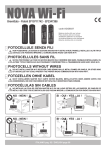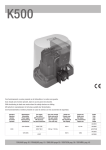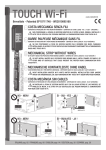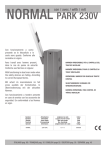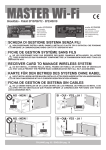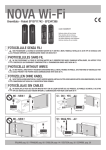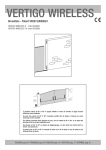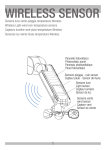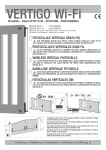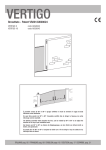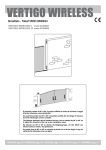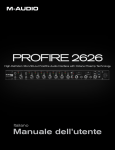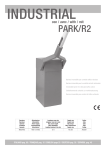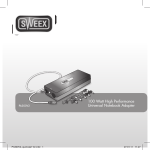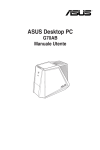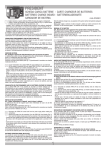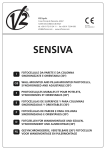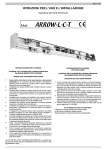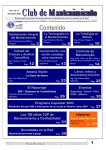Download NOVA WIRELESS CVA1969 rev06 IT-GB
Transcript
NOVA WIRELESS FOTOCELLULE - PHOTOCELLULES PHOTOCELLS - FOTOZELLEN - FOTOCÉLULAS cod. ACG8047 (Batterie AA non incluse - Piles AA non incluses - AA batteries not included - AA Batterien nicht beiliegend - Baterías AA no incluidas) ITALIANO pag. 02 / ENGLISH pag. 07 I SETTAGGI E COLLEGAMENTI TRASMETTITORE SETTAGGI E COLLEGAMENTI RICEVITORE J1 J2 JP1 JP2 JP3 JP4 BAT DLTX AD+ Morsetto di alimentazione 12-24V ac/dc AD- Morsetto di alimentazione 12-24V ac/dc EDGE TX Morsetti per collegamento costa meccanica o resistiva Ponticello abilitazione/esclusione costa (di serie ponticello non inserito per costa non collegata. Chiudere il ponticello se si collega una costa) Ponticello di selezione della portata (15 o 30 metri - impostazione di fabbrica 30 m) Ponticello selezione frequenza (2 disponibili) Ponticello selezione modalità di alimentazione (batteria o rete) Batterie alcaline 2 x AA 1,5V (se non viene utilizzata alimentazione di rete) led verde per verifica funzionamento Morsetto di alimentazione 12-24V ac/dc Morsetto di alimentazione 12-24V ac/dc Comune dei contatti Contatto normalmente chiuso Contatto normalmente aperto Morsetti per collegamento costa meccanica o resistiva JP5 Ponticello abilitazione/esclusione costa (di serie ponticello non inserito per costa non collegata. Chiudere il ponticello se si collega una costa) JP6 Ponticello selezione frequenza (2 disponibili) DLRX Led rosso per segnalare la corretta alimentazione e l’allineamento del segnale infrarosso SCHEMA CON POSIZIONI STANDARD DEI PONTICELLI AD+ AD- COM PHOT NC PHOT NO EDGE RX SCHEMA CON POSIZIONI STANDARD DEI PONTICELLI JP5 BAT DLTX JP6 DLRX JP4 JP3 J1 J2 JP2 JP1 NOTA: O GNI VOLTA CHE SI ESEGUE UNA NUOVA CONFIGURAZIONE TRAMITE PONTICELLO E’ NECESSARIO TOGLIERE E RIDARE ALIMENTAZIONE SIA AL TRASMETTITORE CHE AL RICEVITORE. RIFERIMENTI AUTOMATICI POSSIBILITÁ DI IMPIEGO NORMATIVI PER PORTE E CANCELLI Le fotocellule NOVA WIRELESS, tecnologicamente all’avanguardia, soddisfano completamente l’esigenza di una sicurezza attiva su tutti i tipi di aperture automatiche. Sono prodotte nella versione da parete, da fissare su colonne in ferro o di altro materiale liscio, o su COLONNINE DI SUPPORTO DEDICATE cod. ACG8039. L’installatore deve assicurarsi che l’installazione delle fotocellule NOVA WIRELESS sia fatta solo in presenza di una ulteriore protezione principale come specificato nella norma EN12453 al punto 5.5.1. (requisiti generali di protezione). RIB NON PUÓ CONSIDERARSI RESPONSABILE PER EVENTUALI DANNI CAUSATI DA UN USO IMPROPRIO, ERRONEO O IRRAGIONEVOLE. 2 I MONTAGGIO CPL1311 BC08047R BC08047T CPL1312 CPL1940 N.B.: Prima di posizionare o incollare la dima di foratura (cod. CVA1940) controllare che la superficie di contatto sia pulita. - Fissare le basi plastiche CPL1312 sui pilastri o sulle colonnine ad un’altezza di circa 40÷60 cm dal suolo e ad una distanza max di 10 cm dalla zona di convogliamento o schiacciamento o subito dopo l’ingombro dato da un’eventuale costa. - Terminate le regolazioni montare lo schermo protettivo CPL1311. - Installate il ricevitore in ombra o in una posizione in cui il sole non possa battere orizzontalmente. - In ogni caso si consiglia di posizionare le fotocellule alla stessa altezza e allineate tra loro. - Per il corretto posizionamento delle fotocellule fare riferimento al manuale di installazione dell’operatore o comunque alla norma EN12445. COLLEGAMENTI Utilizzare cavi tipo H05RN-F con fili di sezione minima 0,75 mm2. Se si supera la distanza di 10 m tra fotocellule e quadro di comando, la sezione del filo deve essere aumentata a 1 mm2. ATTENZIONE: Se il led del ricevitore rimane acceso o lampeggia è possibile che siano presenti dei disturbi sulla rete di alimentazione. Vi consigliamo di collegare elettricamente verso terra le colonne o le colonnine di supporto alle fotocellule al morsetto “A/D-” per proteggere A/Dle fotocellule da fonti di disturbo. Fate attenzione a non creare corto circuiti quando le fasi di alimentazione sono invertite! NOTA: E’ possibile collegare sia al ricevitore che al trasmettitore delle coste meccaniche o resistive come riferito nel paragrafo “COLLEGAMENTO DI COSTE MECCANICHE O RESISTIVE”. Contatto N.C. da collegare ai morsetti COM-PHOT Non eseguire il collegamento se si utilizza l’alimentazione a batterie Alimentazione 12/24V ac/dc da collegare ai morsetti AD+ AD- presenti sulle schede RIB 3 I 12/24V ac/dc Se si utilizza l’alimentazione a batterie, posizionare il ponticello JP4 del trasmettitore in questa posizione: 12/24V ac/dc Se si utilizza l’alimentazione esterna, posizionare il ponticello JP4 del trasmettitore in questa posizione: JP4 BATTERIE JP4 BATTERIE Le fotocellule NOVA WIRELESS possono essere installate vicinissime tra di loro grazie alla funzione di SINCRONISMO. Il SINCRONISMO è garantito per 2 coppie di fotocellule agendo sui ponticelli JP3 per il trasmettitore e JP6 per il ricevitore come da disegno sottostante. TX1 RX1 FR1 JP6 JP3 FR1 TX2 RX2 FR2 JP6 JP3 FR2 PORTATA corretta alimentazione e funzionamento. Il led dopo 10 secondi si spegne per non consumare inutilmente l’energia delle batterie, ma la trasmissione del segnale infrarosso continua. È possibile decidere la portata delle fotocellule posizionando un jumper sul/sui trasmettitore/i. ALLINEAMENTO Ponticello JP2 con portata regolata a 30 m (impostazione di fabbrica) H -L e fotocellule NOVA WIRELESS vengono consegnate con allineamento centrale, tuttavia in caso di necessità è possibile eseguire una regolazione dei gruppi ottici del trasmettitore e del ricevitore (+90°/-90° in orizzontale e +5°/-5° in verticale). - Ad allineamento eseguito il led rosso presente sul ricevitore si deve accendere fisso per indicare la corretta ricezione del segnale infrarosso generato dal trasmettitore. Se il led rosso lampeggia => significa che il segnale è debole e quindi l’allineamento è da ottimizzare fino ad ottenere il led rosso acceso fisso. - Se il trasmettitore ed il ricevitore sono montati ad una distanza inferiore a 15 metri, consigliamo di posizionare il ponticello JP2 come indicato nel paragrafo “PORTATA” in questo modo si ha un minor consumo delle batterie con conseguente allungamento della vita delle stesse. - Montare gli schermi protettivi. Ponticello JP2 con portata regolata a 15 m L -D opo aver fissato le basi plastiche delle fotocellule NOVA, inserire le schede elettroniche nelle apposite sedi predisposte sulle basi e quindi fissarle con le viti in dotazione. - Eseguire i collegamenti elettrici come da schema. COLLEGAMENTO BATTERIE AL TRASMETTITORE TX VERIFICA DEL FUNZIONAMENTO Se si desidera utilizzare l’alimentazione a batteria 1,5V, seguire le seguenti indicazioni: - Verificare che il ponticello JP4 sia posizionato per l’alimentazione a batterie. - Inserire le due batterie alcaline tipo AA da 1,5v facendo attenzione alle polarità (si veda immagine a lato). Nel momento dell’inserimento delle batterie sul trasmettitore TX il led verde si accende per 10 secondi segnalando la FUNZIONAMENTO CON SINCRONISMO: - Interporre un’ostacolo davanti al trasmettitore. - Verificare che il led rosso del corrispondente ricevitore si spenga. FUNZIONAMENTO SENZA SINCRONISMO: - Interporre un’ostacolo prima davanti al trasmettitore e poi davanti al ricevitore. - Verificare che il led rosso del ricevitore si spenga in entrambi i casi. 4 I STATO DI ATTENZIONE (avviso di sostituzione batterie) Durante questo periodo il led rosso del ricevitore si spegne segnalando il fermo dell’automazione. Lo stato di attenzione avverte l’utilizzatore dell’imminente necessità di sostituire le batterie. Quando le batterie quasi scariche raggiungono i 2,2V, interponendo un ostacolo oppure transitando attraverso le fotocellule, il trasmettitore segnala al ricevitore lo stato di batterie quasi scariche. Il ricevitore attiva il proprio BUZZER che emette un suono ogni mezzo secondo per 1 minuto. Lo stato di attenzione (il suono del buzzer) si rinnova per 1 minuto ogni qual volta si transiti attraverso le fotocellule. Durante queste segnalazioni il sistema è ancora funzionante, ma è opportuno sostituire al più presto le batterie evitando il fermo della porta che avviene al raggiungimento dei 1,8V. SOSTITUZIONE DELLE BATTERIE La durata delle batterie applicate alle fotocellule NOVA WIRELESS è di circa 3 anni. La sostituzione delle batterie alcaline tipo AA da 1,5V è facile. - Identificare il trasmettitore con le batterie scariche. Per far ciò è sufficiente verificare lo stato dei ricevitori presenti nell’impianto. Se il led rosso di un ricevitore è sempre spento, il corrispondente trasmettitore ha le batterie scariche. - Togliere lo schermo protettivo del trasmettitore. - Sostituire le batterie facendo attenzione al rispetto delle polarità. - Verificare l’accensione del led verde del trasmettitore e l’accensione del led rosso sul ricevitore. - Rimontare lo schermo protettivo del trasmettitore. L’automazione può ripartire in tutta sicurezza. ATTENZIONE: Si ricorda che le batterie vanno smaltite secondo le Norme vigenti. In caso di rottamazione delle fotocellule, si rammenta di togliere le batterie tipo AA e di smaltirle secondo le norme vigenti. STATO DI ALLARME BATTERIE SCARICHE Lo stato di allarme si attiva con batterie completamente scariche (1,8V) o con guasto del trasmettitore della fotocellula. L’allarme viene dato dopo 3 ore di mancata ricezione del segnale infrarosso da parte del ricevitore. Il buzzer del ricevitore emette un suono continuo per 1 minuto ogni 3 ore, fino alla sostituzione delle batterie. IN CASO DI DIFFICOLTA’ SINTOMO VERIFICA Il led verde DLTX del trasmettitore non si accende all’inserimento delle batterie. - Verificare il corretto inserimento con il rispetto delle polarità, OPPURE - Sostituire le batterie in quanto scariche, OPPURE - Se presente una costa collegata al trasmettitore TX e questa risulta impegnata o guasta, verificare l’integrità dei collegamenti e dei contatti della costa e la presenza della resistenza da 8,2kΩ. Il led rosso DLRX del ricevitore risulta spento. - Batterie scariche sul trasmettitore. Sostituirle, OPPURE - Se presente una costa collegata al ricevitore e questa risulta impegnata o guasta, verificare l’integrità dei collegamenti e dei contatti della costa e la presenza della resistenza da 8,2kΩ. Transitando davanti alle fotocellule il buzzer emette un tono ogni 0,5 Sostituire al più presto le batterie del/dei trasmettitori in quanto sono quasi secondi per 1 minuto e la porta continua a funzionare. scariche. Il buzzer sul ricevitore emette un tono continuo per 1 minuto, e la porta non parte. Sostituire le batterie del/dei trasmettitori in quanto scariche. La porta non apre. - Fotocellula non allineata, impegnata o batterie scariche sul trasmettitore, OPPURE - Resistenza da 8,2 kΩ non collegata in serie al contatto N.C. o in parallelo al contatto N.O. della costa collegata sul trasmettitore o sul ricevitore. La costa collegata al trasmettitore o al ricevitore non funziona. Verificare la corretta abilitazione al funzionamento della costa controllando il ponticello JP1 sul trasmettitore e JP5 sul ricevitore. Se i ponticelli risultano corretti staccare e ridare tensione alle fotocellule. COLLEGAMENTO DI COSTE MECCANICHE (TOUCH cod. ACG3015) O RESISTIVE ALLE FOTOCELLULE NOVA WIRELESS -C ollegate ai morsetti EDGE TX per il trasmettitore o EDGE RX per il JP5 ricevitore il contatto N.C. della costa. - Posizionare sul ricevitore il ponticello JP5 nella seguente ON posizione per abilitare la costa. - Posizionare sul trasmettitore il ponticello JP1 nella seguente JP1 ON posizione per abilitare la costa NOTA: LA COSTE COLLEGATE ALLE FOTOCELLULE FANNO REAGIRE IL CANCELLO COME PREVISTO PER LE FOTOCELLULE STESSE. FATE PERTANTO ATTENZIONE A DOVE LE POSIZIONATE. PER COSTE ELETTRICHE CON CONTATTO N.O. - Collegate in parallelo al contatto N.O. della costa una resistenza da 8,2 KΩ (senza tale resistenza il sistema non funziona, vedere tabella “IN CASO DI DIFFICOLTA’) - Collegate ai morsetti EDGE TX per il trasmettitore o EDGE RX per il JP5 ricevitore il contatto N.O. della costa. - Posizionare sul ricevitore il ponticello JP5 nella seguente posizione ON per abilitare la costa. JP1 - Posizionare sul trasmettitore il ponticello JP1 nella seguente ON posizione per abilitare la costa. LE FUNZIONALITA’ DELLE COSTE APPLICATE ALLE FOTOCELLULE SONO LE SEGUENTI: - Se la costa viene premuta DURANTE IL MOVIMENTO DI CHIUSURA, il cancello INVERTE IL MOVIMENTO IN APERTURA. - Se la costa viene premuta DURANTE IL MOVIMENTO DI APERTURA, il cancello INTERROMPE L’APERTURA FIN TANTO che rimane premuta. AL RILASCIO della costa il cancello CONTINUA L’APERTURA. Quest’ultimo comportamento del cancello è vincolato alle impostazioni eseguite sulla centrale di comando. PER COSTE MECCANICHE TOUCH (ACG3015) CON CONTATTO N.C. - Collegate in serie al contatto N.C. della costa una resistenza da 8,2 KΩ (senza tale resistenza il sistema non funziona. Vedere tabella “IN CASO DI DIFFICOLTA’). ESEGUITE UNA VERIFICA FUNZIONALE DELLE COSTE COME SOPRA DESCRITTO. 5 I CARATTERISTICHE TECNICHE TRASMETTITORE NOVA WIRELESS CON FUNZIONAMENTO DA ALIMENTAZIONE ESTERNA - ALIMENTAZIONE 12-24V ac/dc Verificate la compatibilità con l’alimentazione fornita dal quadro elettronico. - ASSORBIMENTO MASSIMO 20 mA - LED VERDE sempre acceso - PORTATA SELEZIONABILE 15 o 30 m (con buone condizioni atmosferiche) N.B.: La portata si può ridurre in presenza di fenomeni atmosferici quali nebbia, pioggia, polvere, ecc. RICEVITORE NOVA WIRELESS - ALIMENTAZIONE 2-24V ac/dc (Verificate la 1 compatibilità con l’alimentazione fornita dal quadro elettronico) - ASSORBIMENTO MASSIMO 110 mA - PORTATA RELE’ 1A - 30 V dc - TEMPO DI ECCITAZIONE RELE’ 120 mS - LED ROSSO acceso => RICEVITORE allineato. (N.B. a taratura avvenuta si spegne quando si interpone un ostacolo) TRASMETTITORE NOVA WIRELESS CON FUNZIONAMENTO A BATTERIE - ALIMENTAZIONE batterie alcaline 2 x AA 1,5V (>2,7Ah) - ASSORBIMENTO 3 µA - VITA DELLE BATTERIE circa 3 anni - VITA BATTERIE CON JUMPER JP2 IN POSIZIONE PORTATA 15 m 4 anni - VITA BATTERIE CON JUMPER JP2 IN POSIZIONE PORTATA 30 m 3 anni - LED VERDE acceso => il trasmettitore è alimentato (questa segnalazione è attiva solo per i primi 10 secondi dall’inserimento batterie). - PORTATA SELEZIONABILE 15 o 30 m (con buone condizioni atmosferiche) N.B.: La portata si può ridurre in presenza di fenomeni atmosferici quali nebbia, pioggia, polvere, ecc. CARATTERISTICHE TECNICHE COMUNI - SEGNALE INFRAROSSO LUNGHEZZA D’ONDA 890 nm - TEMPERATURA DI LAVORO -20°C ÷ +60°C - CONTENITORE esterno in policarbonato interno in abs - GRADO DI PROTEZIONE IP44 - DIMENSIONI 150x45x41 - PESO 0,300 kg OPTIONAL COPPIA COLONNINE NOVA H = 0,5 m COSTA MECCANICA TOUCH cod. ACG8039 L = 2 m - Certificata EN 13849-2 (2008) - Categoria 3 cod. ACG3015 BATTERIE ALCALINE AA BATTERIE LITHIO AA 4 X 1,5V - con NOVA WIRELESS durata batterie 3÷4 anni. cod. ACG9519 2 X 1,5V - con NOVA WIRELESS durata batterie 4÷5 anni. Per temperature estreme -40÷+60°C. cod. ACG9509 6 G B SETTINGS AND TRANSMITTER CONNECTIONS SETTINGS AND RECEIVER CONNECTIONS J1 JP1 J2 JP5 JP2 JP3 JP4 BAT DLTX AD+ Feed terminal 12-24V ac/dc AD- Feed terminal 12-24V ac/dc EDGE TX Feed terminals for mechanical or resistive strip Strip enabling/disabling jumper (standard jumper not inserted for unconnected strip. Disable the jumper if a strip is connected) Range selector jumper (15 or 30 meters - factory setting 30 m) Frequency selector jumper (2 available) Power selector jumper (battery or network) Alkaline batteries 2 x AA 1,5V (if network power is not used) Green LED function indicator AD+ Feed terminal 12-24V ac/dc AD- Feed terminal 12-24V ac/dc COM Contact system PHOT NC Contact normally closed PHOT NO Contact normally open EDGE RX Feed terminals for mechanical or resistive strip Strip enabling/disabling jumper (standard jumper not inserted for unconnected strip. Disable the jumper if a strip is connected) JP6 Frequency selector jumper (2 available) DLRX Red LED indicating correct power and infrared signal alignment STANDARD POSITIONS JUMPERS STANDARD POSITIONS JUMPERS JP5 BAT DLTX JP6 DLRX JP4 JP3 J1 J2 JP2 JP1 NOTE: E ACH TIME A NEW JUMPER CONFIGURATION IS USED IT IS NECESSARY TO TURN OFF AND TURN ON POWER TO BOTH THE TRANSMITTER AND THE RECEIVER. REFERENCE AND DOORS USES TO STANDARDS FOR AUTOMATIC GATES NOVA WIRELESS photocells are technologically advanced and completely meet the active security demands of all types of automatic opening systems. They are produced in versions for wall mounting, for mounting to columns of iron or other smooth material, or on dedicated SUPPORT COLUMNS cod. ACG8039. The installer must ensure that the installation of the NOVA WIRELESS photocells is performed only in the presence of further protection as specified by standard EN12453 in 5.5.1. (general protection requirements). RIB MAY NOT BE HELD RESPONSIBLE FOR DAMAGES CAUSED BY IMPROPER, WRONG OR UNREASONABLE USE. 7 G B MOUNTING CPL1311 BC08047R BC08047T CPL1312 CPL1940 N.B.: Before placing the drilling template (code CVA1940) make sure that the contact surface is clean. - Affix the plastic bases CPL1312 to the pillars or columns about 40÷60 cm from the ground and at a maximum distance of 10 cm from the conveyance or pressure area or immediately out of range of any protruding edge. - After adjustment attach the protective casing CPL1311. - Install the receiver in a shaded area or in a position not exposed to horizontal sunlight. - In every case it is advisable to place the photocells at the same height and in line with each other. - For the correct positioning of the photocells refer to the user installation manual or to standard EN12445. CONNECTIONS Use H05RN-F cables, with a minimum section of 0,75 mm2. If you exceed the distance of 10 m between photocells and control panel, the wire section must be increased to 1 mm2. ATTENTION: In case the receiver led remains lit, malfunctioning of the main supply is suspected. It is advisable to connect electrically the photocells stands A/Dto the contact “A/D-”, to shield the photocells from external noise. Be careful not to short circuit the system when the supply phases are inverted! NOTE: It is possible to connect both the transmitter and the receiver to mechanical or resistive strips as shown in the paragraph “CONNECTION OF MECHANICAL OR RESISTIVE STRIP”. Contact N.C. to connect to terminals COM-PHOT Power 12/24V ac/dc to connect to terminals AD+ ADon the RIB control panels Do not perform the connection when using battery power. 8 G B 12/24V ac/dc If battery power is used, place the transmitter jumper JP4 in this position: 12/24V ac/dc If an external power source is used, place the transmitter jumper JP4 in this position. JP4 BATTERIE JP4 BATTERIE NOVA Wi-Fi photocells may be installed very close together thanks to SYNCHRONIZATION. SYNCHRONIZATION is guaranteed for up to 2 pairs of photocells working on the jumpers JP3 for the transmitter and JP6 for the receiver as shown below. TX1 RX1 FR1 JP6 JP3 FR1 TX2 RX2 FR2 JP6 JP3 FR2 RANGE ALIGNMENT -N OVA WIRELESS photocells are packaged with central alignment however, if necessary, it is possible to adjust the optical units of the transmitter and receiver (+90°/-90° horizontally and +5°/-5° vertically). - After performing the alignment the red LED on the receiver must emit a constant light to indicate correct reception of the infrared signal from the transmitter. If the red LED is flashing it means that the signal is weak and that the alignment must be improved until the red LED emits a constant light. - If the transmitter and the receiver are mounted at a distance of less than 15 meters, we recommend positioning the jumper JP2 as indicated in the paragraph “RANGE”. This will provide lower battery consumption and consequently add to their duration. - Mount the protective cover. It is possible to adjust the range of the photocells by placing a jumper on the transmitter(s). Jumper JP2 with a range of 30 m (factory setting) H Jumper JP2 with a range of 15 m L -A fter affixing the plastic bases of the NOVA WIRELESS photocells, insert the circuit boards into the proper places on the bases and attach them with the supplied screws. - Make the electrical connections as in the diagram. SYSTEM CHECK SYNCHRONIZATION: - Place an object in front of the transmitter. - Check that the red LED of the corresponding receiver turns off. NO SYNCHRONIZATION: - Place an object in front of the transmitter and then in front of the receiver. - Check that the red LED of the receivers is off in both cases. CONNECTING THE BATTERY TO THE TRANSMITTER TX If 1,5V battery power is desired, follow these instructions: - Check that jumper JP4 is set for battery power. - Insert the two AA 1,5V Alkaline batteries checking that the polarity is correct (see side image). Upon insertion of the batteries into the transmitter TX the green LED will light for 10 seconds indicating that it works correctly. The LED then shuts off so as not to waste battery energy, but the infrared signal is active. 9 G B WARNING (replace the batteries) The WARNING tells the user of the immediate need to replace the batteries. When battery power reaches 2,2V, placing or moving an object between the photocells causes the transmitter to signal the receiver of the low battery status. The receiver activates the BUZZER which emits a sound every half second for 1 minute. The warning (the sound of the buzzer) is renewed for 1 minute every time something passes between the photocells. The system is still operational during these signals, but it is advantageous to replace the batteries as soon as possible in order to avoid a full stop of the door operation which happens when the batteries reach 1,8V. LOW BATTERY ALARM The alarm activates when the batteries have been exhausted (1,8V) or when a photocell is not working. The alarm sounds 3 hours after the loss of the infrared signal by the receiver. The receiver buzzer emits a continuous sound for 1 minute every 3 hours, until the batteries have been replaced. During this time the red LED of the receiver shuts off signaling the stop of automation. CHANGING THE BATTERIES The duration of the batteries used for NOVA WIRELESS photocells is about 3 years. Replacing the Alkaline batteries AA 1,5V is easy. - Identify the transmitter with the exhausted batteries. To do this simply check the status of the system receiver. If the red LED of a receiver is always off, the batteries of the corresponding transmitter are exhausted. - Remove the protective cover from the transmitter. - Replace the batteries checking that the polarity is correct. - Check that the green LED of the transmitter and the red LED of the receiver are on. - Replace the protective cover on the transmitter. L’automazione può ripartire in tutta sicurezza. ATTENTION: Please remember that batteries must be disposed of properly according to current standards. In case of disposal of the photocells please remember to remove the AA batteries and dispose of them properly. IN CASE OF DIFFICULTY PROBLEM CHECK The green LED DLTX of the transmitter does not come on when the battery is inserted. - Check that the polarity of the batteries is correct, or - Replace exhausted batteries, or - If a strip is connected to the transmitter TX and this is stuck or not working, check the strip contacts and connections and the presence of resistance of 8,2kΩ. The red LED DLRX of the receiver does not come on. - Transmitter batteries are exhausted. Replace them or - If a strip is connected to the receiver and this is stuck or not working, check the sensor contacts and connections and the presence of resistance of 8,2kΩ. Moving in front of the photocells the buzzer emits a sound every 5 second for 1 minute and the door continues to function. Replace the batteries of the transmitter(s) as they are exhausted. The receiver buzzer emits a continuous sound for 1 minute and the door does not move. Replace the batteries of the transmitter(s) as they are exhausted. The door does not open. - The photocell is not aligned, stuck or the transmitter has exhausted batteries, or - Resistance of 8,2 kΩ is not connected in series to the N.C. contact or in parallel to the N.O. contact of the strip connected to the transmitter or receiver. The strip connected to the transmitter or receiver does not work. Check the correct operation enabling of the sensor by checking jumper JP1 on the transmitter and JP5 on the receiver. If the jumpers are correct turn off and then turn on power to the photocells. CONNECTION OF THE MECHANICAL (TOUCH code ACG3015) OR RESISTIVE TRIPS TO THE NOVA WIRELESS PHOTOCELLS NOTE: THE STRIPS CONNECTED TO THE PHOTOCELLS MAKE THE DOOR REACT AS TO THE PHOTOCELLS THEMSELVES. THEREFORE PAY ATTENTION TO WHERE THEY ARE POSITIONED. THE FUNCTIONALITY OF THE STRIPS APPLIED TO THE PHOTOCELLS ARE AS FOLLOWS: - if activated while the door is CLOSING => REVERSES THE OPENING MOVEMENT; - if activated while the door is OPENING => INTERRUPTS THE OPENING MOVEMENT for the time that it is held. Upon being RELEASED the door continues to open. The latter behavior of the door depends on the setting of the control panel. FOR TOUCH (ACG3015) MECHANICAL STRIPS WITH CONTACT N.C. - Connect in series to the N.C. contact of the strip a resistance of 8,2 KΩ (without this resistance the series will not work and the alarm will come on - see table “TROUBLESHOOTING’) -C onnect the strip N.C. contact to the feed terminals EDGE TX for the JP5 transmitter or EDGE RX for the receiver. - Place the jumper JP5 on the receiver in the following position to ON enable the strip: JP1 - Place the jumper JP1 on the transmitter in the following ON position to enable the strip: FOR RESISTIVE STRIPS WITH N.O. CONTACT - Connect in parallel to the N.O. contact of the strip a resistance of 8,2 KΩ (without this resistance the series will not work and the alarm will come on - see table “TROUBLESHOOTING’) - Connect the strip N.O. contact to the feed terminals EDGE TX for the JP5 transmitter or EDGE RX for the receiver. - Place the jumper JP5 on the receiver in the following position to ON enable the strip: JP1 - Place the jumper JP1 on the transmitter in the following ON position to enable the strip: PERFORM A SYSTEM CHECK ON THE SENSORS AS INDICATED ABOVE. 10 G B TECHNICAL SPECIFICATIONS NOVA WIRELESS RECEIVER - POWER NOVA WIRELESS EXTERNALLY POWERED TRANSMITTER - POWER 12-24V ac/dc (Check compatibility of power supplied by the electric panel) - MAXIMUM ABSORPTION 20 mA - GREEN LED always on - ADJUSTABLE RANGE 15 o 30 m (in good weather conditions) N.B.: Range may be reduced in bad weather conditions such as fog, rain, dust, etc. 2-24V ac/dc (Check 1 compatibility of power supplied by the electric panel) 110 mA 1A - 30 V dc 120 mS on => RECEIVER aligned. (N.B. when adjusted it turns off when an object is placed in front of it) MAXIMUM ABSORPTION RELAY RANGE RELAY STROKE TIME RED LED NOVA WIRELESS BATTERY OPERATED TRANSMITTER - POWER alkaline batteries 2 x AA 1,5V(>2,7Ah) - POWER ABSORBED 3 µA - BATTERY LIFE about 3 years - BATTERY LIFE WITH JP2 SET ON 15 m RANGE 4 years - BATTERY LIFE WITH JP2 SET ON 30 m RANGE 3 years - GREEN LED on => the transmitter is aligned (this signal is only active for the first 10 seconds after the batteries have been inserted). - ADJUSTABLE RANGE 15 o 30 m (in good weather conditions) N.B.: Range may be reduced in bad weather conditions such as fog, rain, dust, etc. COMMON TECHNICAL SPECIFICATIONS - INFRARED SIGNAL WAVELENGTH 890 nm - OPERATING TEMPERATURE -20°C ÷ +60°C - CONTAINER exterior in polycarbonate internal in abs - PROTECTION LEVEL IP44 - DIMENSIONS 150x45x41 - WEIGHT 0,300 kg ACCESSORIES PAIR OF COLUMNS for NOVA H = 0,5 m TOUCH MECHANICAL STRIP code ACG8039 L = 2 m - Certified EN 13849-2 (2008) - Category 3 AA ALKALINE BATTERIES code ACG3015 AA LITHIO BATTERIES 4 X 1,5V - battery life with NOVA WIRELESS 3÷4 years. 2 X 1,5V - battery life with NOVA WIRELESS 4÷5 years. For extreme temperatures -40÷+60°C. code ACG9509 code ACG9519 11 NOVA WIRELESS DICHIARAZIONE DI CONFORMITÁ - DÉCLARATION DE CONFORMITÉ DECLARATION OF COMPLIANCE - DECLARACIÓN DE CONFORMIDAD Dichiariamo sotto la nostra responsabilità che NOVA WIRELESS è conforme alle seguenti norme e Direttive: NOVA WIRELESS se conforme aux normes suivantes: We declare under our responsibility that NOVA WIRELESS is conform to the following standards: Wir erklaeren das NOVA WIRELESS den folgenden EN-Normen entspricht: Declaramos bajo nuestra responsabilidad que NOVA WIRELESS ed conforme a la siguientes normas y disposiciones: EN 12978 EN 55014-1 EN 55014-2 EN 60335-1 2003 2000 1997 2008 EN 61000-3-2 EN 61000-3-3 EN 61000-6-1 EN 61000-6-2 2007 1997 2007 2006 EN 61000-6-3 EN 61000-6-4 2007 2007 Come richiesto dalle seguenti Direttive - Conformément aux Directives As is provided by the following Directives - Gemaß den folgenden Richtlinien Tal y como requerido por las siguientes Disposiciones: 2006/95/CE 2004/108/CE Il presente prodotto non può funzionare in modo indipendente ed è destinato ad essere incorporato in un impianto costituito da ulteriori elementi. Rientra perciò nell’Art. 6 paragrafo 2 della Direttiva 2006/42/CE (Macchine) e successive modifiche, per cui segnaliamo il divieto di messa in servizio prima che l’impianto sia stato dichiarato conforme alle disposizioni della Direttiva. Le présent dispositif ne peut fonctionner de manière indépendante, étant prévu pour être intégré à une installation constituée d’autres éléments. Aussi rentre-t-il dans le champ d’application de l’art. 6, paragraphe 2 de la Directive machines 2006/42/CEE et de ses modifications successives. Sa mise en service est interdite avant que l’installation ait été déclarée conforme aux dispositions prévues par la Directive. This product can not work alone and was designed to be fitted into a system made up of various other elements. Hence, it falls within Article 6, Paragraph 2 of the EC-Directive 2006/42 (Machines) and following modifications, to which respect we point out the ban on its putting into service before being found compliant with what is provided by the Directive. Dieses Produkt kann nicht allein funktionieren und wurde konstruiert, um in einen von anderen Bestandteilen zusammengesetzten System eingebaut zu werden. Das Produkt fällt deswegen unter Artikel 6, Paragraph 2 der EWG-Richtlinie 2006/42 (Maschinen) und folgenden. El presente producto no puede funcionar de manera independiente y está destinado a ser incorporado en un equipo constituido por ulteriores elementos. Entra por lo tanto en el Art. 6 párrafo 2 de la Directiva 2006/42/CEE (Máquinas) y sucesivas modificaciones, por lo que señalamos la prohibición de puesta en servicio antes de que el equipo haya sido declarado conforme con las disposiciones de la Directiva. Legal Representative (Rasconi Antonio) 25014 CASTENEDOLO (BS) - ITALY Via Matteotti, 162 Tel. +39.030.2135811 Fax +39.030.21358279 www.ribind.it - [email protected] Cod. CVA1969 - 20032012 - Rev. 06 Questo prodotto è stato completamente progettato e costruito in Italia · Ce produit a été complètement développé et fabriqué en Italie · This product has been completely developed and built in Italy · Dieses Produkt wurde komplett in Italien entwickelt und hergestellt · Artìculo totalmente proyectado y producido en Italia












